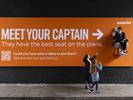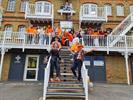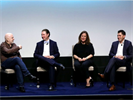Paul Holmes 31 Dec 2001 // 12:00AM GMT
For nearly 20 years, james martin+co (jm+co) quietly built a sterling reputation as the consultants to the consultants. IT managers and project managers at dozens of companies turned to jm+co for the latest processes and methodologies to ensure that their technological solutions also made good business sense. A year and a half ago, however, faced with an aging corporate identity and increased competition, the private company’s board of directors gave their executive team an ultimatum: either find a buyer for the company, or re-focus the company. At the time, opportunities in the “e-consulting” space—which includes companies like Scient, Viant, Sapient, Razorfish, Proxicom, iXL, marchFIRST and others, not to mention the “Big 5” consulting companies—seemed endless. The sector was growing rapidly, and the company set its sights on re-launching itself in that exciting space.
In March of this year, with the company well on its way to its transformation, the NASDAQ entered a correction. The long-predicted “demise of the dot-coms” was upon us, and the market cooled rapidly not only for Internet startups, but also for the companies that rely on ‘dot-com’ companies as customers, including Scient, Viant and the others. jm+co did not scrap their plans for re-launching themselves, however. They enlisted The Leonhardt Group (TLG) to help them create their new corporate identity and brand. In July, 2000, jm+co unveiled its new identity—Headstrong—to its employees. Headstrong was a success from the start because of its superior achievement in branding and reputation.
OBJECTIVES
Shortly before the internal launch, Weber Shandwick Worldwide (WSW) was hired to:
AUDIENCE
WSW worked closely with both jm+co and TLG, providing counsel from the very beginning on outreach strategies for the company’s key audiences, including current and prospective customers, partners, and other important constituencies. In an industry that often competes as much for talent as it does for customers, employee outreach—both current and prospective—was identified as a critical activity. Though Headstrong is a privately-held corporation, outreach to prospective investors is also a consideration. All of these audiences can be reached through media and analyst outreach.
RESEARCH
During the ‘education’ phase of the campaign (see Planning, Strategy and Execution Below), WSW researched a number of recent developments in the industry and in the company itself to identify news angles, potential press releases and other opportunities for publicity. WSW determined that the recent investment of US $191 million jm+co received from two major investors was the largest infusion of private equity in an Internet consulting firm in the last several years. Given the state of the industry, the agency adopted a “contrarian” investor story angle: at a time when competitors were announcing revenue downturns, layoffs and other negative developments, jm+co—now Headstrong—has received a major investment, giving the company a vote of confidence.
PLANNING, STRATEGY AND EXECUTION
WSW employed a three-stage campaign strategy to reach these audiences. The first stage was an education stage that concentrated on identifying news angles, key messages and other critical communication elements. It included the basic elements of any PR campaign, including message and media training, the creation of PR collateral and other critical components. During this phase WSW also conducted industry analyst outreach to pre-brief key analysts on the new company and test the company’s key messages. Feedback from these analyst meetings was incorporated into the final messaging and PR collateral.
The second stage of the campaign involved a broad campaign to generate basic awareness of the new company. WSW treated the creation of Headstrong as a new company launch backed by a 20-year industry veteran (jm+co) and $191 in new funding. WSW prepared an outreach strategy to convey this and other key messages to a wide range of media and analyst outlets. The new company was launched worldwide on September 13 and 14, 2000. The Headstrong launch was coordinated across the U.S., Asia Pacific and Europe, reflecting the company’s longstanding international presence. To reach as broad of an audience as possible, the WSW team brought the company’s Interactive Public Relations team on board to conduct a web conference call to launch the company, announce the new name and the $191 million investment. (A Web presentation from this conference is part of included collateral.)
The third stage of the campaign involves more targeted outreach. WSW and Headstrong have employed an “influence the influencers” strategy to reach out to key analysts and media to get on the “short list” of e-consultancies. This phase includes feature outreach, as well as news release development, the development of a speakers’ bureau program and other ongoing key PR activities.
CHALLENGES & OBSTACLES
Almost immediately, WSW put into place a crisis communication plan in the event that the new identity leaked between the time of the internal launch—in June—and the planned public launch in September. The company’s plans for a new identity had already been leaked—to the Washington Post—earlier that year, and the agency had to plan for the possibility that the new name itself would leak. WSW advised jm+co to keep its employees informed on a regular basis as to the status of the company’s plans for a public launch. WSW prepared several contingency releases that could be issued in the event of a news leak. Further implications were that the company’s launch was to take place after a particularly difficult time in their industry sector resulting in media and analysts becoming increasingly critical after the market’s downturn earlier in the year.
MEASUREMENT OF SUCCESS
Launch Day: Web presentation
WSW teams from the U.S., Asia Pacific and Europe combined to execute a unique and successful launch of Headstrong. Utilizing our virtual presentation technology, WSW executed a live Web briefing for more than 60 editors, tying in Headstrong executives who presented simultaneously from locations in Hong Kong, Tokyo, London and New York City.
Coverage resulting from the launch included The Washington Post, CNNfn, Internet.com, eCompany Now, Washington Business Journal, Wall Street Journal, WSJ.com, Red Herring, and many others. Nearly 80 interviews were held and Headstrong's Web site registered a five-fold increase in traffic.
Media Coverage to Date:
Media coverage results of the global launch of Headstrong and other company announcements have been steady and respectable. This submission includes a number of articles reflecting Headstrong’s most notable global coverage to date.
To verify coverage, WSW uses Lexis Nexis, Dow Jones, eWatch, and other Internet publication resources. We supplement these services with outreach to individual reporters who expressed initial interest in Headstrong to determine the status of upcoming articles. Unfortunately, no clipping or monitoring service captures everything so the figure shown below is, at best, conservative.
During the September 12, 2000 through January 31, 2001 time period, 106 articles and TV/radio Headstrong hits were generated. The below figures show an estimated circulation of the media coverage to date.
Based on WSW’s PR efforts, the total media impressions garnered to date are 409,711,824.
In March of this year, with the company well on its way to its transformation, the NASDAQ entered a correction. The long-predicted “demise of the dot-coms” was upon us, and the market cooled rapidly not only for Internet startups, but also for the companies that rely on ‘dot-com’ companies as customers, including Scient, Viant and the others. jm+co did not scrap their plans for re-launching themselves, however. They enlisted The Leonhardt Group (TLG) to help them create their new corporate identity and brand. In July, 2000, jm+co unveiled its new identity—Headstrong—to its employees. Headstrong was a success from the start because of its superior achievement in branding and reputation.
OBJECTIVES
Shortly before the internal launch, Weber Shandwick Worldwide (WSW) was hired to:
- generate global media interest
- gain mind share
- drive brand awareness
- embrace the momentum
AUDIENCE
WSW worked closely with both jm+co and TLG, providing counsel from the very beginning on outreach strategies for the company’s key audiences, including current and prospective customers, partners, and other important constituencies. In an industry that often competes as much for talent as it does for customers, employee outreach—both current and prospective—was identified as a critical activity. Though Headstrong is a privately-held corporation, outreach to prospective investors is also a consideration. All of these audiences can be reached through media and analyst outreach.
RESEARCH
During the ‘education’ phase of the campaign (see Planning, Strategy and Execution Below), WSW researched a number of recent developments in the industry and in the company itself to identify news angles, potential press releases and other opportunities for publicity. WSW determined that the recent investment of US $191 million jm+co received from two major investors was the largest infusion of private equity in an Internet consulting firm in the last several years. Given the state of the industry, the agency adopted a “contrarian” investor story angle: at a time when competitors were announcing revenue downturns, layoffs and other negative developments, jm+co—now Headstrong—has received a major investment, giving the company a vote of confidence.
PLANNING, STRATEGY AND EXECUTION
WSW employed a three-stage campaign strategy to reach these audiences. The first stage was an education stage that concentrated on identifying news angles, key messages and other critical communication elements. It included the basic elements of any PR campaign, including message and media training, the creation of PR collateral and other critical components. During this phase WSW also conducted industry analyst outreach to pre-brief key analysts on the new company and test the company’s key messages. Feedback from these analyst meetings was incorporated into the final messaging and PR collateral.
The second stage of the campaign involved a broad campaign to generate basic awareness of the new company. WSW treated the creation of Headstrong as a new company launch backed by a 20-year industry veteran (jm+co) and $191 in new funding. WSW prepared an outreach strategy to convey this and other key messages to a wide range of media and analyst outlets. The new company was launched worldwide on September 13 and 14, 2000. The Headstrong launch was coordinated across the U.S., Asia Pacific and Europe, reflecting the company’s longstanding international presence. To reach as broad of an audience as possible, the WSW team brought the company’s Interactive Public Relations team on board to conduct a web conference call to launch the company, announce the new name and the $191 million investment. (A Web presentation from this conference is part of included collateral.)
The third stage of the campaign involves more targeted outreach. WSW and Headstrong have employed an “influence the influencers” strategy to reach out to key analysts and media to get on the “short list” of e-consultancies. This phase includes feature outreach, as well as news release development, the development of a speakers’ bureau program and other ongoing key PR activities.
CHALLENGES & OBSTACLES
Almost immediately, WSW put into place a crisis communication plan in the event that the new identity leaked between the time of the internal launch—in June—and the planned public launch in September. The company’s plans for a new identity had already been leaked—to the Washington Post—earlier that year, and the agency had to plan for the possibility that the new name itself would leak. WSW advised jm+co to keep its employees informed on a regular basis as to the status of the company’s plans for a public launch. WSW prepared several contingency releases that could be issued in the event of a news leak. Further implications were that the company’s launch was to take place after a particularly difficult time in their industry sector resulting in media and analysts becoming increasingly critical after the market’s downturn earlier in the year.
MEASUREMENT OF SUCCESS
Launch Day: Web presentation
WSW teams from the U.S., Asia Pacific and Europe combined to execute a unique and successful launch of Headstrong. Utilizing our virtual presentation technology, WSW executed a live Web briefing for more than 60 editors, tying in Headstrong executives who presented simultaneously from locations in Hong Kong, Tokyo, London and New York City.
Coverage resulting from the launch included The Washington Post, CNNfn, Internet.com, eCompany Now, Washington Business Journal, Wall Street Journal, WSJ.com, Red Herring, and many others. Nearly 80 interviews were held and Headstrong's Web site registered a five-fold increase in traffic.
Media Coverage to Date:
Media coverage results of the global launch of Headstrong and other company announcements have been steady and respectable. This submission includes a number of articles reflecting Headstrong’s most notable global coverage to date.
To verify coverage, WSW uses Lexis Nexis, Dow Jones, eWatch, and other Internet publication resources. We supplement these services with outreach to individual reporters who expressed initial interest in Headstrong to determine the status of upcoming articles. Unfortunately, no clipping or monitoring service captures everything so the figure shown below is, at best, conservative.
During the September 12, 2000 through January 31, 2001 time period, 106 articles and TV/radio Headstrong hits were generated. The below figures show an estimated circulation of the media coverage to date.
Based on WSW’s PR efforts, the total media impressions garnered to date are 409,711,824.


































.jpg)

















